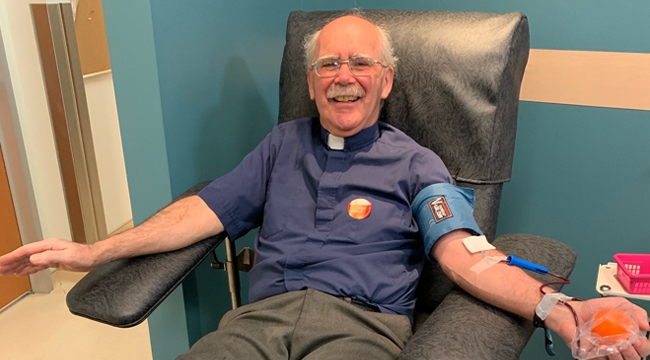For patients like Journey, the need for blood never stops
Since birth, nine-year-old Journey Dickson has required regular, lifesaving blood transfusions to manage his rare blood disorder
Like many other kids his age, nine-year-old Journey Dickson has had to grapple with certain elements of his childhood being put on hold for the past year, due to COVID-19.
Outings with friends, in-classroom learning, swimming lessons and weekend trips with his family to the trampoline park have all been out of the question since the pandemic was declared in March 2020.
One part of everyday life that hasn’t changed for Journey, however, is his ongoing need for blood transfusions.
“We used to go out and do activities all the time as a family — now, the only place Journey gets to go is the hospital,” said his mother, Coriena.
Every three weeks, in fact, Journey must skip a day of online school, suit up in his protective mask and visor and prepare for a full day of blood work and transfusions.
While his grade four classmates learn about science and biology, Journey is living it — getting hooked up to an IV line to receive multiple units of red blood cells and intravenous immunoglobulin (IVIg), a product made from donated plasma that helps patients fight infection.
This is because Journey was born with Diamond Blackfan Anemia (DBA), a rare blood disorder that affects the bone marrow. People who live with DBA produce little to no red blood cells (which carry oxygen to the body’s tissues). This means that regular blood transfusions often become a critical part of life to help prevent anemia; a condition that can result in symptoms like fatigue, weakness and shortness of breath
Many patients with DBA rely on blood transfusions from birth. For Journey, his need for blood started even sooner than most.
When Coriena was 31 weeks pregnant with Journey, it was discovered that he had Tetralogy of Fallot, a rare condition caused by a combination of four heart defects that are present at birth. He received his first blood transfusion in utero and was diagnosed with DBA soon after.
“We knew from then that his life would be a journey, so that’s how we came up with his name,” said Coriena.
Over the past decade, Journey has received hundreds of blood transfusions and has undergone five heart surgeries. During the COVID-19 pandemic, treating Journey’s condition has presented several new challenges.
Journey is currently more susceptible to his hemoglobin levels dropping, due to the risk of the virus and associated stressors. Because cold weather can also drop Journey’s hemoglobin to dangerously low levels, even a short walk outside or a drive to the hospital to receive blood transfusions can put his health at a heightened risk on especially frigid days in his hometown of Calgary, Atla.
Prior to the pandemic, Journey had managed to get his iron levels to an acceptable level, to the point that he was a viable candidate for a stem cell transplant — something his doctors had been working towards for years.
He had been scheduled to receive healthy stem cells from his older sister in 2020, but those plans unfortunately had to be put on hold when COVID-19 hit.
“Once we finally got Journey’s iron levels down, the world around him completely changed,” said Coriena.
“Only emergency transplants are happening right now because of COVID-19, so for the foreseeable future, we have to keep managing his health through blood transfusions.”
The plan is still for Journey to undergo a stem cell transplant when it becomes possible again, to help improve his immune system. If all goes well, his need for blood transfusions and IVIg may stop completely.
However, there is no silver bullet for treatment when it comes to DBA.
“There is no cure for DBA, or any guarantee that blood transfusions won’t be needed again down the road,” said Coriena.
“We’re pretty sure that for Journey, the need for blood will always be a part of life.”
Your monthly financial donations can help patients like Journey.

Journey poses for a family photo with his siblings and his father (from left to right: Brock, Hope, Journey, and Doug)
Need for blood spans generations for the Dicksons
For the Dickson family, the ongoing need for lifesaving blood products to treat DBA doesn’t end with Journey. In fact, this critical need has spanned generations.
Journey’s father, Doug, also lives with the same rare blood disorder and has required regular blood transfusions since his diagnosis at the age of 20.
While his DBA diagnosis came much later in life than his son’s, Doug believes that like Journey, he also suffered from the disorder since birth.
“Growing up, I would get tired and breathless a lot, but my doctors just thought I had asthma,” said Doug.
When Doug was 20 years old, he was prescribed antibiotics to treat an infection. The medication caused his hemoglobin to drop to such a low level that he passed out and had to be hospitalized.
Doug’s doctors weren’t sure at first what was causing his blood counts to be so low. He had no family history of illness on his mother’s side and had not known the whereabouts of his father since he was a young child.
Doug began receiving blood transfusions right away, but it wasn’t until he learned about his father’s medical history that the puzzle pieces finally fit together.
“When I went for a blood transfusion one day, the clerk asked what my full name and date of birth was, as she had someone with the exact same name [in her files],” he said.
“By fate, it turned out that the other Doug Dickson was in fact my biological father. We decided to meet up and he explained to me the disorder he suffered from. He felt horrible that it looked as though he had passed [DBA] on to me.”
Soon after that meeting, Doug was officially diagnosed with DBA and regular blood transfusions quickly became a part of his life.
Now 33, Doug still receives blood transfusions approximately every six weeks.
“It’s really hard to see both [Doug and Journey suffer],” said Coriena. “Especially with Journey, it’s tough to see him go through all these things his brother and sister don’t.”
Fortunately, Journey’s older siblings, Brock and Hope, do not share the same health struggles as Journey, Doug and Doug Sr.; who sadly passed away in 2016 due to complications from DBA.
Coriena and Doug hold on to hope that in Journey’s lifetime, scientists will discover a cure for DBA. In the meantime, both father and son must continue to rely on the lifesaving power of blood transfusions.
“The world around us may have changed this past year, but for people like Journey and Doug, the need for blood is just as important as ever,” said Coriena.
“I’m so grateful for all the donors who not only help my family, but who help all the other patients across Canada whose lives depend on these precious gifts.”
How your monthly financial donations can help patients like Journey
Donating blood is one way you can help support patients like Journey and Doug, but did you know you can also make an important difference by becoming a monthly financial donor of Canadian Blood Services?
Our generous community of financial donors help connect patients with the lifesaving blood products they need, month after month and year after year.
Monthly financial giving helps grow and diversify our community of blood, plasma and stem cell donors to meet changing patient needs. Financial donations also allow us to invest in innovative technologies and helps fuel cutting-edge research in transplantation and transfusion medicine.
Together with our monthly financial donors, we can do more, faster, to help save lives.
Learn how you can become a monthly financial donor today.
If you are eligible, you can also help support patients by making an appointment to donate blood or plasma or starting the registration process to become a stem cell donor.



